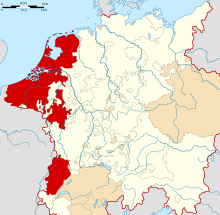
Back Бургундски имперски окръг Bulgarian Cercle de Borgonya Catalan Burgundský kraj Czech Burgundischer Reichskreis German Κύκλος της Βουργουνδίας Greek Burgonja imperia cirklo Esperanto Círculo de Borgoña Spanish Burgundia ringkond Estonian Cercle de Bourgogne French Burgundiai körzet Hungarian
| Burgundian Circle Burgundischer Kreis | |
|---|---|
| |
| 1512–1797 | |
 The Burgundian Circle after 1548 within the Holy Roman Empire | |
| Historical era | Early modern period |
• Established | 1512 |
• Secession of the Seven United Provinces | 1648 |
• Disestablished | 1797 |
| Today part of | |
The Burgundian Circle (German: Burgundischer Kreis, Dutch: Bourgondische Kreits, French: Cercle de Bourgogne) was an Imperial Circle of the Holy Roman Empire created in 1512 and significantly enlarged in 1548. In addition to the Free County of Burgundy (the former administrative region of Franche-Comté), the Burgundian Circle roughly covered the Low Countries, i.e., the areas now known as the Netherlands, Belgium and Luxembourg and adjacent parts in the French administrative region of Nord-Pas-de-Calais. For most of its history, its lands were coterminous with the holdings of the Spanish Habsburgs in the Empire (Franche-Comté and the Habsburg Netherlands).
The circle's territorial scope was reduced considerably in the 17th century with the secession of the Seven United Provinces in 1581 (recognized 1648 under the Treaty of Westphalia) and the annexation of the Free County of Burgundy by France in 1678. Consequently, in the 18th century the circle was known as Austrian Netherlands as the Austrian Habsburgs had obtained the territory from Spain earlier in that century. The occupation and subsequent annexation of Imperial territory to the west of the Rhine river by Revolutionary France in the 1790s effectively brought an end to the circle's existence.